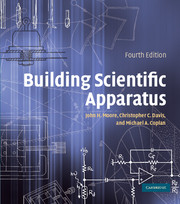Preface
Published online by Cambridge University Press: 05 August 2012
Summary
Building Scientific Apparatus provides an overview of the physical principles that one must grasp to make useful and creative decisions in the design of scientific apparatus. We also describe skills, such as mechanical drawing, circuit analysis, and optical ray-tracing and matrix methods that are required to design an instrument. A large part of the text is devoted to components. For each class of components – electrical, optical, thermal and so on – the parameters used by manufacturers to specify their products are defined. Useful materials and components such as infrared detectors, metal alloys, optical materials, and operational amplifiers are discussed, and examples and performance specifications are given. Of course, having designed an apparatus and chosen the necessary components, one must build it. We deal in considerable detail with basic laboratory skills: soldering electrical components, glassblowing, brazing, polishing, and so on. Described in lesser detail are operations such as lathe turning, milling, casting, laser cutting, and printed-circuit production, which one might let out to an outside shop. Understanding the capabilities and limitations of shop processes is necessary to fully exploit them in designing and building an instrument. Overall, we recognize that there are many engineering and technical texts that cover every aspect of instrument design; our goal in Building Scientific Apparatus has been to winnow the available information down to the essentials required for practical work by the designer and builder of scientific instruments.
- Type
- Chapter
- Information
- Building Scientific Apparatus , pp. xiii - xivPublisher: Cambridge University PressPrint publication year: 2009

